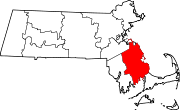Hingham, MA
History




The town of Hingham was dubbed "Bare Cove" by the first colonizing English in 1633, but two years later was incorporated as a town under the name "Hingham." The land on which Hingham was settled was deeded to the English by the Wampanoag sachem Wompatuck in 1655. The town was within Suffolk County from its founding in 1643 until 1803, and Plymouth County from 1803 to the present. The eastern part of the town split off to become Cohasset in 1770. The town was named for Hingham, a market town in the English county of Norfolk, whence most of the first colonists came, including Abraham Lincoln's ancestor Samuel Lincoln (1622–1690), his first American ancestor, who came to Massachusetts in 1637. A statue of President Lincoln adorns the area adjacent to downtown Hingham Square.
Hingham was born of religious dissent. Many of the original founders were forced to flee their native town in Norfolk with both their vicars, Rev. Peter Hobart and Rev. Robert Peck, when they fell afoul of the strict doctrines of the Church of England. Peck was known for what the eminent Norfolk historian Rev. Francis Blomefield called his "violent schismatical spirit". Peck lowered the chancel railing of the church, in accord with Puritan sentiment that the Anglican church of the day was too removed from its parishioners. He also antagonized ecclesiastical authorities with other forbidden practices.
Hobart, born in Hingham, Norfolk, in 1604 and, like Peck, a graduate of Magdalene College, Cambridge, sought shelter from the prevailing discipline of the high church among his fellow Puritans. The cost to those who emigrated was steep. They "sold their possessions for half their value," noted a contemporary account, "and named the place of their settlement after their natal town." (The cost to the place they left behind was also high: Hingham was forced to petition Parliament for aid, claiming that the departure of its most well-to-do citizens had left it hamstrung.)
While most of the early Hingham settlers came from Hingham and other nearby villages in East Anglia, a few Hingham settlers like Anthony Eames came from the West Country of England. The early settlers of Dorchester, Massachusetts, for instance, had come under the guidance of Rev. John White of Dorchester in Dorset, and some of them (like Eames) later moved to Hingham. Accounts from Hingham's earliest years indicate some friction between the disparate groups, culminating in a 1645 episode involving the town's "trainband", when some Hingham settlers supported Eames, and others supported Bozoan Allen, a prominent early Hingham settler and Hobart ally who came from King's Lynn in Norfolk. Prominent East Anglian Puritans like the Hobarts and the Cushings, for instance, were used to holding sway in matters of governance. Eventually the controversy became so heated that John Winthrop and Thomas Dudley were drawn into the fray; minister Hobart threatened to excommunicate Eames.
The bitter trainband controversy dragged on for several years, culminating in stiff fines. Eventually a weary Eames, who was in his mid-fifties when the controversy began and who had served Hingham as first militia captain, a selectman, and Deputy in the General Court, threw in the towel and moved to nearby Marshfield where he again served as Deputy and emerged as a leading citizen, despite his brush with the Hingham powers-that-be.
Although the town was incorporated in 1635, the colonists did not get around to negotiating purchase from the Wampanoag, the Native American tribe in the region, until three decades later. On July 4, 1665, the tribe's chief sachem, Josiah Wompatuck, sold the township to Capt. Joshua Hobart (brother of Rev. Peter Hobart) and Ensign John Thaxter (father of Col. Samuel Thaxter), representatives of Hingham's colonial residents. Having occupied the land for 30 years, the Englishmen presumably felt entitled to a steep discount. The sum promised Josiah Wompatuck for the land encompassing Hingham was to be paid by two Hingham landowners: Lieut. John Smith and Deacon John Leavitt, who had been granted 12 acres (49,000 m) on Hingham's Turkey Hill earlier that year. Now the two men were instructed to deliver payment for their 12-acre (49,000 m) grant to Josiah the chief Sachem. The grant to Smith and Leavitt — who together bought other large tracts from the Native Americans for themselves and their partners—was "on condition that they satisfy all the charge about the purchase of the town's land of Josiah—Indian sagamore, both the principal purchase and all the other charge that hath been about it". With that payment the matter was considered settled.
The third town clerk of Hingham was Daniel Cushing, who emigrated to Hingham from Hingham, Norfolk, with his father Matthew in 1638. Cushing's meticulous records of early Hingham enabled subsequent town historians to reconstruct much of early Hingham history as well as that of the early families. Cushing was rather unusual in that he included the town's gossip along with the more conventional formal record-keeping.
Geography
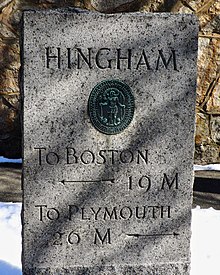
According to the United States Census Bureau, the town has a total area of 26.3 square miles (68.1 km), of which 22.2 square miles (57.5 km) is land and 4.1 square miles (10.6 km), or 15.58%, is water. Hingham is bordered on the east by Cohasset, and Scituate, on the south by Norwell and Rockland, on the west by Weymouth, and on the north by Hingham Bay and Hull. Cohasset and Weymouth are in Norfolk County; the other towns, like Hingham itself, are in Plymouth County. Hingham is 14 miles (23 km) southeast of Boston.
Hingham lies along the southwestern corner of Boston Harbor. The bay leads to a harbor, which cuts a U-shaped indentation into the northern shore of the town. The town is separated from Hull by the Weir River and its tributary, which leads to the Straits Pond. The northern third of the town's border with Weymouth consists of the Weymouth Back River, which empties out into Hingham Bay. There are several other small ponds and brooks throughout town. The town also has several forests and parks, the largest of which, Wompatuck State Park, spreads into the neighboring towns of Cohasset, Scituate and Norwell. There are also several conservation areas throughout town; the portion of the Boston Harbor Islands National Recreation Area in Hingham includes Bumpkin Island, Button Island, Langlee Island, Ragged Island, Sarah Island and the World's End Reservation, which juts out into the bay. There is a marina along the mouth of the Weymouth Back River, and a public beach along the harbor.
Demographics
| Year | Pop. | ±% |
|---|---|---|
| 1850 | 3,980 | — |
| 1860 | 4,351 | +9.3% |
| 1870 | 4,422 | +1.6% |
| 1880 | 4,485 | +1.4% |
| 1890 | 4,564 | +1.8% |
| 1900 | 5,059 | +10.8% |
| 1910 | 4,965 | −1.9% |
| 1920 | 5,604 | +12.9% |
| 1930 | 6,657 | +18.8% |
| 1940 | 8,003 | +20.2% |
| 1950 | 10,665 | +33.3% |
| 1960 | 15,378 | +44.2% |
| 1970 | 18,845 | +22.5% |
| 1980 | 20,339 | +7.9% |
| 1990 | 19,821 | −2.5% |
| 2000 | 19,882 | +0.3% |
| 2010 | 22,157 | +11.4% |
| 2020 | 24,284 | +9.6% |
| 2022* | 24,130 | −0.6% |
| * = population estimate. Source: United States Census records and Population Estimates Program data. | ||
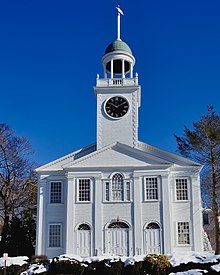
The U.S. Census Bureau estimates, there are 24,284 people and 8,873 households in the town. The population density was 884.8 inhabitants per square mile (341.6/km). There were 7,368 housing units at an average density of 327.9 per square mile (126.6/km). The racial makeup of the town was 97.5% White, 0.40% Black or African American, 0.04% Native American, 0.88% Asian, 0.02% Pacific Islander, 0.22% from other races, and 0.95% from two or more races. Hispanic or Latino of any race were 0.75% of the population.
There were 7,189 households, out of which 37.8% had children under the age of 18 living with them, 65.7% were married couples living together, 8.5% had a female householder with no husband present, and 23.8% were non-families. 21.0% of all households were made up of individuals, and 10.1% had someone living alone who was 65 years of age or older. The average household size was 2.72 and the average family size was 3.19.
In the town, the population was spread out, with 27.7% under the age of 18, 4.3% from 18 to 24, 26.3% from 25 to 44, 27.5% from 45 to 64, and 14.1% who were 65 years of age or older. The median age was 40 years. For every 100 females, there were 89.5 males. For every 100 females age 18 and over, there were 85.6 males.
The median household income in the town was $142,435 (mean household income was $206,876), and the median family income was $198,900 (mean family income was $265,292) in 2019. Males had a median income of $66,802 versus $41,370 for females. The per capita income in 2019 for the town was $78,301. About 2.4% of families and 3.5% of the population were below the poverty line, including 4.7% of those under age 18 and 3.1% of those age 65 or over.
Economy
Top employers
According to the Town's 2017 Comprehensive Annual Financial Report, the top employers in the town are:
| # | Employer | # of employees |
|---|---|---|
| 1 | Blue Cross/Blue Shield | 1,456 |
| 2 | Town of Hingham | 985 |
| 3 | Linden Ponds | 802 |
| 4 | Talbots | 461 |
| 5 | Serono Laboratories | 437 |
| 6 | Harbor House | 247 |
| 7 | Whole Foods | 212 |
| 8 | Stop & Shop | 196 |
| 9 | Russ Electric | 191 |
| 10 | Eat Well | 170 |
Government
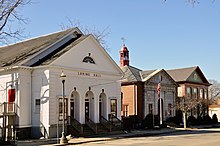
On the national level, Hingham is a part of Massachusetts's 8th congressional district, and is currently represented by Stephen F. Lynch. The state's senior member of the United States Senate is Elizabeth Warren. The state's junior Senator is Ed Markey, who was elected in a special election in 2013 to fill the seat vacated by John Kerry being appointed as United States Secretary of State.
On the state level, Hingham is represented in the Massachusetts House of Representatives as a part of the Third Plymouth district, by Joan Meschino. The district also includes Cohasset, Hull and North Scituate. The town is represented in the Massachusetts Senate as a part of the Plymouth and Norfolk district, by Patrick O'Connor. The district also includes the towns of Cohasset, Duxbury, Hull, Marshfield, Norwell, Scituate and Weymouth. The town is patrolled on a secondary basis by the First (Norwell) Barracks of Troop D of the Massachusetts State Police.
Hingham is governed on the local level by the open town meeting form of government, and is led by a town administrator and a three-member select board. The members of the board of selectmen are William Ramsey, Liz Klein, and Joe Fisher. The town hall is located in the former Central Junior High School building, which it moved into in 1995. The town has its own police and fire departments, with a central police station next to the town hall and fire houses located near the town common, in West Hingham, and in South Hingham. The town's nearest hospital is South Shore Hospital in Weymouth, where all emergency calls are sent. There are two post offices in town, one in downtown Hingham on North Street and another in South Hingham right on Route 53. The town's public library is located on Leavitt Street in Center Hingham, and is part of the Old Colony Library Network.
| Voter Registration and Party Enrollment as of October 15, 2008 | |||||
|---|---|---|---|---|---|
| Party | Number of Voters | Percentage | |||
| Democratic | 4,101 | 25.63% | |||
| Republican | 2,976 | 18.60% | |||
| Unaffiliated | 8,870 | 55.43% | |||
| Libertarian | 56 | 0.35% | |||
| Total | 16,003 | 100% | |||
Infrastructure
Education
Hingham is home to seven public schools:
- Hingham High School
- South Shore Educational Collaborative
- Hingham Middle School
- East Elementary School
- Foster Elementary School
- Plymouth River Elementary School
- South Elementary School
Hingham is home to five private schools:
- Derby Academy
- Notre Dame Academy
- St. Paul School
- Old Colony Montessori School
- Su Escuela Language Academy
Transportation
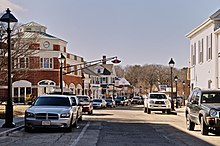
A small portion of Route 3 passes through the southwestern corner of town, with one exit in town and another at Route 228 just south of the town line. Routes 3A and 53 also cross through the town, the latter mirroring the path of Route 3. Route 228 passes from north to south in town; the rest all pass from west to east.
Public transportation is currently served by the commuter boat ferry service from the Hingham Shipyard to Rowes Wharf in downtown Boston, the MBTA's Bus Route 220, with Route 222 also passing through a small section of town, and the MBTA Commuter Rail to Boston South Station. Commuter rail has been restored along the Greenbush Line through Hingham. Trains stop at two stations in town; West Hingham and Nantasket Junction. As part of the MBTA's agreement to restore train service, a tunnel has been built to carry the commuter trains under historic Hingham Square. There were disputes in Hingham about whether to allow the train to pass through the town. Some people felt that Hingham is becoming less like a town and more like a small city. Others felt that the line would benefit the town. Ferries also run from Hingham Shipyard to several islands in Boston Harbor during the summer as well as to Pemberton Point, Hull. There is no air service in the town; the nearest airport is Logan International Airport in Boston as well as smaller public airports in Norwood and Marshfield.
Notable people


Hingham's most famous line of citizens came from two unrelated families named Lincoln who emigrated to Massachusetts from the English county of Norfolk in the seventeenth century, from Hingham and Swanton Morley, respectively. A bridge in Hingham over Route 3, the Southeast Expressway, is named after American Revolutionary War General Benjamin Lincoln of the Swanton branch. General Lincoln is best remembered for accepting Cornwallis's sword of surrender at the Siege of Yorktown. But the most famous Hingham Lincoln never lived in the town: United States President and Civil War Commander-in-Chief Abraham Lincoln, descended from one of several Lincoln families who settled in Hingham – and unrelated to General Benjamin. A bronze statue, a replica of the famous sitting Lincoln Memorial in Washington D.C. sits at the foot of Lincoln Street at North Street.
- Tony Amonte, retired hockey player in the NHL
- John F. Andrew, 19th century United States Congressman
- Joanna Barnes, actress
- Bill Belichick owns a house in Hingham in the Black Rock Country Club residential community
- Matty Beniers, current ice hockey player in the NHL. The first ever draft pick by the Seattle Kraken
- Brian Boyle, current ice hockey player in the NHL
- Wilmon Brewer, lifelong Hingham author and philanthropist
- Mary A. Brinkman, homeopathic physician
- Marc Brown, author, illustrator, and creator of the children's television show Arthur
- Prescott Bush Jr., brother of 41st President George H. W. Bush and Uncle of 43rd President George W. Bush
- Herbert L. Foss, recipient of the Medal of Honor in the Spanish–American War
- Bob Graham, former governor and senator from Florida and a 2004 presidential candidate resided part time in Hingham
- Harold Hackett, four-time U.S. Open tennis doubles champion
- Lloyd P. Jones, Bethlehem Steel executive and son of Willard F. Jones, resided with his family in Hingham while working at the Bethlehem Shipbuilding Corporation
- King Kelly, 19th Century Baseball Hall of Fame. Given a home on Main Street, Hingham by loving fans of Boston. Slide, Kelly, Slide (Scarecrow Press 1996)
- Bruce H. Mann, Harvard Law School professor and husband of presidential candidate Elizabeth Warren
- David McCullough, author and historian resided part-time in Hingham
- Pierre McGuire, ice hockey analyst and former NHL coach and scout
- Marty McInnis, retired hockey player in the NHL
- Alice Merryweather, Olympic alpine skier
- Jay O'Brien, ice hockey player
- Judson Pratt, stage, film and television actor
- Dallas Lore Sharp, professor at Boston University, settled with his family (including Waitstill Sharp) in Hingham. He wrote magazine articles on native birds and small mammals, and books. Much of his writing celebrated Hingham's natural beauty.
References
- ^ "What is a Hingham Bucket?".
- ^ "Town of Hingham Massachusetts, Incorporated 1635 - History". Archived from the original on July 17, 2010. Retrieved July 10, 2010.
- ^ (Mass.), Hingham; Bouvé, Thomas Tracy; Bouvé, Edward Tracy; Long, John Davis; Bouvé, Walter Lincoln; Lincoln, Francis Henry; Lincoln, George; Hersey, Edmund; Burr, Fearing (1893). "History of the town of Hingham, Massachusetts". town: 185.
{{cite journal}}: Cite journal requires|journal=(help) - ^ "Hingham, Massachusetts". Hingham, Massachusetts. Retrieved August 25, 2012.
- ^ "Census - Geography Profile: Hingham town, Plymouth County, Massachusetts". United States Census Bureau. Retrieved November 4, 2021.
- ^ "Profile for Hingham, Massachusetts, MA". ePodunk. Archived from the original on February 4, 2012. Retrieved August 25, 2012.
- ^ Barber, John Warner (January 1, 1844). Historical Collections: Being a General Collection of Interesting Facts, Traditions, Biographical Sketches, Anecdotes, &c., Relating to the History and Antiquities of Every Town in Massachusetts, with Geographical Descriptions. W. Lazell – via Internet Archive.
- ^ "History of Wompatuck". Retrieved April 12, 2012.
- ^ "Hingham: Norfolk's undiscovered Georgian gem..." Archived from the original on October 8, 2007. Retrieved October 21, 2007.
- ^ Reynolds, Matthew (January 1, 2005). Godly Reformers and Their Opponents in Early Modern England: Religion in Norwich, C.1560-1643. Boydell Press. ISBN 9781843831495 – via Google Books.
- ^ "Rootsweb details for Robert Peck (c. 1580–1658)". Retrieved October 28, 2020.
- ^ "Peter HUBBERD Alias: Peter HOBART (HBRT621P)". A Cambridge Alumni Database. University of Cambridge.
- ^ History of the Town of Hingham, Massachusetts. Town of Hingham. January 1, 1893 – via Internet Archive.
- ^ (Mass.), Hingham; Bouvé, Thomas Tracy; Bouvé, Edward Tracy; Long, John Davis; Bouvé, Walter Lincoln; Lincoln, Francis Henry; Lincoln, George; Hersey, Edmund; Burr, Fearing; Seymour, Charles Winfield Scott (January 1, 1893). "History of the Town of Hingham, Massachusetts". town – via Google Books.
- ^ Palfrey, John Gorham (January 1, 1860). "History of New England - Volume II" – via Google Books.
- ^ "Samuel Ward (circa 1593-1682) - England; Hingham, Plymouth, co., MA; Hull, Plymouth co., MA; Charlestown, Suffolk co., MA".
- ^ Waters, John J. (January 1, 1968). "Hingham, Massachusetts, 1631-1661: An East Anglian Oligarchy in the New World". Journal of Social History. 1 (4): 351–370. doi:10.1353/jsh/1.4.351. JSTOR 3786629.
- ^ Bremer, Francis J. (June 16, 2003). John Winthrop: America's Forgotten Founding Father. Oxford University Press, USA. ISBN 978-0-19-514913-5 – via Internet Archive.
- ^ Winthrop, John (January 1, 1853). The history of New England from 1630 to 1649. Little, Brown and Co. – via Internet Archive.
- ^ Bigelow, Edwin Victor (January 1, 1898). A Narrative History of the Town of Cohasset, Massachusetts. Press of S. Usher – via Internet Archive.
- ^ Hingham's early settlers intermarried extensively. Town clerk Daniel Cushing, for instance, was brother-in-law to John Leavitt, founding deacon of Old Ship Church, for whom today's Leavitt Street is named. (They married daughters of Edward Gilman Sr., who settled in Hingham before moving to Exeter, New Hampshire. The immigrant Edward Gilman's sister Bridget married Edward Lincoln, father of Samuel Lincoln, ancestor of Abraham Lincoln.) Later the Cushing and Leavitt families themselves intermarried — resulting in descendants named both Leavitt Cushing and Cushing Leavitt.
- ^ Cushing, Lemuel (January 1, 1877). The Genealogy of the Cushing Family. Lovell printing and publishing Company – via Internet Archive.
- ^ Tarbell, Ida Minerva (January 1, 1924). Abraham Lincoln and His Ancestors. University of Nebraska Press. ISBN 0803294301 – via Google Books.
- ^ Cutter, William Richard (January 1, 1908). "Historic Homes and Places and Genealogical and Personal Memoirs Relating to the Families of Middlesex County, Massachusetts". Lewis historical publishing Company – via Google Books.
- ^ "Geographic Identifiers: 2010 Demographic Profile Data (G001): Hingham town, Plymouth County, Massachusetts". United States Census Bureau. Retrieved March 19, 2012.
- ^ "TOTAL POPULATION (P1), 2010 Census Summary File 1, All County Subdivisions within Massachusetts". United States Census Bureau. Archived from the original on February 12, 2020. Retrieved September 13, 2011.
- ^ "Massachusetts by Place and County Subdivision - GCT-T1. Population Estimates". United States Census Bureau. Archived from the original on November 3, 2011. Retrieved July 12, 2011.
- ^ "1990 Census of Population, General Population Characteristics: Massachusetts" (PDF). US Census Bureau. December 1990. Table 76: General Characteristics of Persons, Households, and Families: 1990. 1990 CP-1-23. Archived from the original (PDF) on December 7, 2013. Retrieved July 12, 2011.
- ^ "1980 Census of the Population, Number of Inhabitants: Massachusetts" (PDF). US Census Bureau. December 1981. Table 4. Populations of County Subdivisions: 1960 to 1980. PC80-1-A23. Retrieved July 12, 2011.
- ^ "1950 Census of Population" (PDF). 1: Number of Inhabitants. Bureau of the Census. 1952. Section 6, Pages 21-10 and 21-11, Massachusetts Table 6. Population of Counties by Minor Civil Divisions: 1930 to 1950. Retrieved July 12, 2011.
{{cite journal}}: Cite journal requires|journal=(help) - ^ "1920 Census of Population" (PDF). Bureau of the Census. Number of Inhabitants, by Counties and Minor Civil Divisions. Pages 21-5 through 21-7. Massachusetts Table 2. Population of Counties by Minor Civil Divisions: 1920, 1910, and 1920. Retrieved July 12, 2011.
- ^ "1890 Census of the Population" (PDF). Department of the Interior, Census Office. Pages 179 through 182. Massachusetts Table 5. Population of States and Territories by Minor Civil Divisions: 1880 and 1890. Retrieved July 12, 2011.
- ^ "City and Town Population Totals: 2020-2022". United States Census Bureau. Retrieved November 23, 2023.
- ^ "U.S. Census Bureau "QuickFacts"". U.S. Census Bureau. Retrieved September 14, 2021.
- ^ "factfinder.census.gov for Hingham, MA, 2000 census". Archived from the original on February 12, 2020. Retrieved November 5, 2008.
- ^ "Explore Census Data". data.census.gov. Retrieved September 14, 2021.
- ^ "Town of Hingham CAFR". Retrieved October 28, 2020.
- ^ "Representative Joan Meschino". malegislature.gov. Retrieved March 27, 2018.
- ^ "We've Moved". Archived from the original on September 29, 2007. Retrieved March 8, 2007.
- ^ "Mass.gov". www.mass.gov. Retrieved October 28, 2020.
- ^ "Registration and Party Enrollment Statistics as of October 15, 2008" (PDF). Massachusetts Elections Division. Retrieved May 8, 2010.
- ^ "South Shore Educational Collaborative".
- ^ "Hingham Middle School".
- ^ "East Elementary School - Welcome to East!".
- ^ "Foster Elementary School".
- ^ "Plymouth River Elementary School".
- ^ "South Elementary School".
- ^ "Saint Paul School".
- ^ "Old Colony Montessori School".
- ^ "Su Escuela Language Academy - Creative. Confident. Bi-lingual".
- ^ "AF Pedigree View Page". FamilySearch. September 26, 2007. Archived from the original on September 26, 2007. Retrieved October 28, 2020.
- ^ "AF Pedigree View Page". FamilySearch. September 26, 2007. Archived from the original on September 26, 2007. Retrieved October 28, 2020.
- ^ Who Was Who in America, Historical Volume, 1607–1896. Marquis Who's Who. 1967.
- ^ O'Connor, Anahad (June 24, 2010). "Prescott Bush Jr., Scion of a Political Family, Dies at 87". The New York Times. Retrieved June 25, 2010.
- ^ "Bostonherald.com". Retrieved October 28, 2020.
- ^ Gordon, Joe (November 18, 1993). "McGuire makes name for himself". The Boston Globe.
- ^ "Higham Boy Awarded Drama Scholarship". The Boston Globe. May 1, 1935. p. 5. Retrieved January 6, 2024.
External links
- Official website
- Hingham Historical Society
- Hingham Public Library
- Early Settlers of Hingham, History of Hingham, 1893
- History of the Town of Hingham, Massachusetts, Vol. I, Thomas Tracy Bouvé and others, Published by the Town, 1893
- Hingham's Civil War monuments at Massachusetts Civil War Monuments Project
